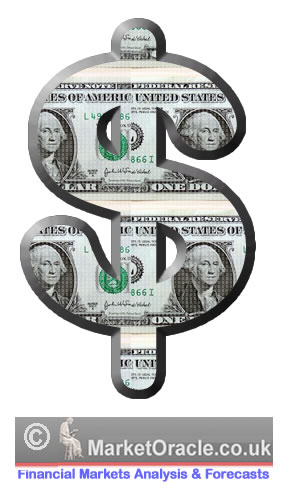U.S. Treasury Bonds the Biggest Bubble of All?
Interest-Rates / US Bonds Dec 05, 2008 - 07:29 AM GMT Mike Larson writes: We've lived through some truly historic bubbles in recent years:
Mike Larson writes: We've lived through some truly historic bubbles in recent years:
• The dot-com bubble was a doozy …
• The housing bubble was even bigger, and …
• Now I'm wondering if we aren't dealing with a NEW bubble — a bubble in the market for long-term U.S. government debt, or “Treasuries” for short.
I'm not talking about short-term Treasuries or Treasury-only money funds. Those are securities with very short-term maturities — six months, three months, one month and so on. They're a great place to park your money for the ultimate in safety and security.
I'm talking about long-term Treasuries — 10-year notes and 30-year bonds. They're subject to all kinds of long-term risks — currency risk for foreign debt holders … inflation risk for domestic and foreign investors … and, if you believe the credit default swap market, even a wee bit of CREDIT risk.
Buyers Piling in, Then Piling in Some More …
 |
| Investors piling into long-term U.S. debt like never before have left Treasuries yielding lows not seen since the mid-1950s. |
Right now, investors are dog-piling into long-term U.S. debt like never before.
I prefer to use the long bond futures market as a good gauge of demand and pricing. And prices recently surged about 22 points — in just one month. On a percentage basis, that comes to 19.9%.
I don't know how familiar you are with how bonds work. But that is literally unprecedented in terms of both magnitude and speed. Just consider:
- In mid-2003, the Fed was openly fretting about deflation. The federal funds rate was on its way to 1%. Bonds had what was then considered a huge rally — but it only came to 13.3% in two months .
- Immediately after the 9/11 attacks, bonds started rallying amid expectations the economy would slow. Then the government took the unprecedented step of cancelling 30-year Treasury Bond auctions. The idea was to make bonds scarcer, causing prices to surge and long-term rates to fall. The “gigantic” rally that ensued? A gain of about 9.8% over the span of a month and a half .
- You probably remember the Long Term Capital Management crisis if you've been around the markets for a while. Back in 1998, Russia defaulted on its sovereign debt. That set off a massive liquidation of higher-risk debt and an enormous flood of money into Treasuries among investors seeking safety. But the total rally amounted to just 11.1% in two months .
I think you catch my drift: Treasury bonds almost NEVER move this far, this fast. And interest rates, which move in the opposite direction of bond prices, almost never fall this far, this fast.
The yield on the 10-year Treasury Note plunged from a mid-October high of 4.08% to a low of 2.67% this week. That's a move of a whopping 135 basis points, or 1.41 percentage points, in only a month and a half. And it has left Treasuries yielding lows not seen since the mid-1950s.
You Can Thank, Or Blame, the Fed …
Bonds had already been rising in price due to concerns about the economy and deflation. But the surge was turbocharged by the Fed's announcement several days ago that it would print money out of thin air and buy long-term debt.
 |
| Fed Chairman Ben Bernanke's latest strategy has a big, fat fatal flaw … |
So far, the Fed has only committed to buying mortgage backed securities and debt issued by Fannie Mae and Freddie Mac. But in a speech, Fed Chairman Ben Bernanke also hinted at the possibility the Fed could expand its plan to include Treasuries rather than just “agency” debt.
But Can This Bond Market Rally Last?
I'm skeptical. Think about it: If governments could just print their own money, buy their own debt, and SUCCEED without consequences, why wouldn't every single government in the world do the same thing?
What a great way to spur growth by driving down consumer and corporate financing rates since they follow Treasury yields … right?
But they CAN'T!
The strategy has a fatal flaw — namely that no government, or central bank, is bigger than the bond and currency markets. Foreign bondholders aren't going to sit idly by while any government … even the government of the U.S. … openly decides to trash its currency by printing it with reckless abandon. And they aren't going to sit by while the government manipulates prices higher.
They're going to say “Sold to you!” and take their money elsewhere.
Then there's the exploding budget deficit and the ballooning bailout commitments of the U.S. Treasury. By my count the U.S. government has loaned, invested or committed …
- $200 billion to nationalize the world's two largest mortgage companies, Fannie Mae and Freddie Mac;
- $25 billion for the Big Three auto manufacturers;
- $29 billion for Bear Stearns;
- $150 billion for AIG;
- $350 billion for Citigroup;
- $300 billion for the Federal Housing Administration rescue bill to refinance bad mortgages;
- $87 billion to pay back JPMorgan Chase for bad Lehman Brothers trades;
- $200 billion in loans to banks under the Fed's Reserve Term Auction Facility (TAF);
- $50 billion to support short-term corporate IOUs held by money market mutual funds;
- $500 billion to rescue various credit markets;
- $620 billion for industrial nations, including the Bank of Canada, Bank of England, Bank of Japan, National Bank of Denmark, European Central Bank, Bank of Norway, Reserve Bank of Australia, Bank of Sweden, and Swiss National Bank;
- $120 billion in aid for emerging markets, including the central banks of Brazil, Mexico, South Korea and Singapore;
- Trillions to guarantee the FDIC's new, expanded bank deposit insurance coverage from $100,000 to $250,000; plus …
- More trillions for other sweeping guarantees.
The grand total? A mind-blowing $7.8 trillion and counting!
How much is that?
 |
| So far, the U.S. government has loaned, invested or committed a staggering $25,507 for every single man, woman, and child in the United States. |
- That's half the yearly output of the entire U.S. economy.
- It's equal to $25,507 for every single man, woman, and child in the United States.
- In the more than 200 years the U.S. has been a nation, it has racked up almost $10.7 trillion in public debt. Now, in just a matter of months, policymakers have added contingent and direct obligations equal to almost three-fourths of that amount.
Last week, I asked how the heck we were going to pay for this stuff.
The truth is the U.S. government is going to have to flood the market with a wave of Treasuries the likes of which the world has never seen. And just like any other market, the bond market reacts to supply and demand.
Too much supply and not enough demand should drive prices lower.
Bottom line: There are lots of reasons to believe this Treasury rally is unsustainable, and that a day of reckoning is fast approaching.
Until next time,
Mike
This investment news is brought to you by Money and Markets . Money and Markets is a free daily investment newsletter from Martin D. Weiss and Weiss Research analysts offering the latest investing news and financial insights for the stock market, including tips and advice on investing in gold, energy and oil. Dr. Weiss is a leader in the fields of investing, interest rates, financial safety and economic forecasting. To view archives or subscribe, visit http://www.moneyandmarkets.com .
Money and Markets Archive |
© 2005-2022 http://www.MarketOracle.co.uk - The Market Oracle is a FREE Daily Financial Markets Analysis & Forecasting online publication.



